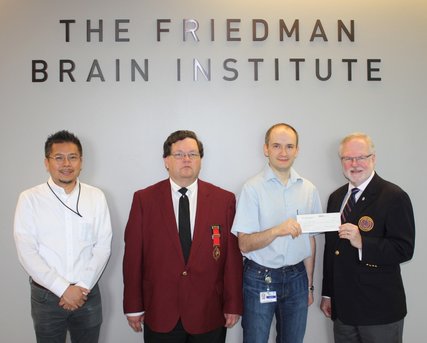Yury Garkun, PhD, receives a Career-Starter Research Grant for 2017-2018 from the Knights Templar Eye Foundation.
NEW YORK – May 27, 2017 /Press Release/ ––
Mount Sinai School of Medicine researcher Yury Garkun, PhD, has received a Career-Starter Research Grant for 2017-2018 from the Knights Templar Eye Foundation.
Dr. Garkun, Postdoctoral Fellow in the lab of Dr. Hirofumi Morishita MD PhD at the department of Psychiatry, Neuroscience, Ophthalmology, Friedman Brain Institute and the Mindich Child Health and Development Institute at Mount Sinai School of Medicine, was awarded the grant for his work entitled, "Removing proteolytic brake from inhibitory circuits for recovery from Amblyopia". The grant of $65,000 was given to Dr. Yarkun on May 27th.
"Our long-term goal is to identify key regulatory mechanisms of plasticity to provide therapeutic targets for Amblyopia," said Dr. Garkun. "We recently identified a novel 'molecular brake' again proteolysis which increases in adulthood to actively limit plasticity in mouse visual cortex."
A 'lazy eye' or monocular cataract early in life results in an enduring loss of visual acuity (amblyopia) reflecting aberrant circuit remodeling within the primary visual cortex. Amblyopia affects two to four percent of the human population and exhibits little recovery in adulthood. Successful therapies for Amblyopia are therefore contingent on understanding the mechanism of adult brain plasticity.
The objective of the study is to uncover molecular and circuit mechanisms of the adult plasticity normally masked by this molecular brake. The identified mechanisms will provide novel targets for multiple interventions in amblyopia.
The Knights Templar Eye Foundation supports research that can help launch the careers of clinical or basic researchers committed to the prevention and cure of potentially blinding diseases in infants and children. They support clinical or basic research on conditions that can or may eventually be treated or prevented.
NEW YORK – May 27, 2017 /Press Release/ ––
Mount Sinai School of Medicine researcher Yury Garkun, PhD, has received a Career-Starter Research Grant for 2017-2018 from the Knights Templar Eye Foundation.
Dr. Garkun, Postdoctoral Fellow in the lab of Dr. Hirofumi Morishita MD PhD at the department of Psychiatry, Neuroscience, Ophthalmology, Friedman Brain Institute and the Mindich Child Health and Development Institute at Mount Sinai School of Medicine, was awarded the grant for his work entitled, "Removing proteolytic brake from inhibitory circuits for recovery from Amblyopia". The grant of $65,000 was given to Dr. Yarkun on May 27th.
"Our long-term goal is to identify key regulatory mechanisms of plasticity to provide therapeutic targets for Amblyopia," said Dr. Garkun. "We recently identified a novel 'molecular brake' again proteolysis which increases in adulthood to actively limit plasticity in mouse visual cortex."
A 'lazy eye' or monocular cataract early in life results in an enduring loss of visual acuity (amblyopia) reflecting aberrant circuit remodeling within the primary visual cortex. Amblyopia affects two to four percent of the human population and exhibits little recovery in adulthood. Successful therapies for Amblyopia are therefore contingent on understanding the mechanism of adult brain plasticity.
The objective of the study is to uncover molecular and circuit mechanisms of the adult plasticity normally masked by this molecular brake. The identified mechanisms will provide novel targets for multiple interventions in amblyopia.
The Knights Templar Eye Foundation supports research that can help launch the careers of clinical or basic researchers committed to the prevention and cure of potentially blinding diseases in infants and children. They support clinical or basic research on conditions that can or may eventually be treated or prevented.

